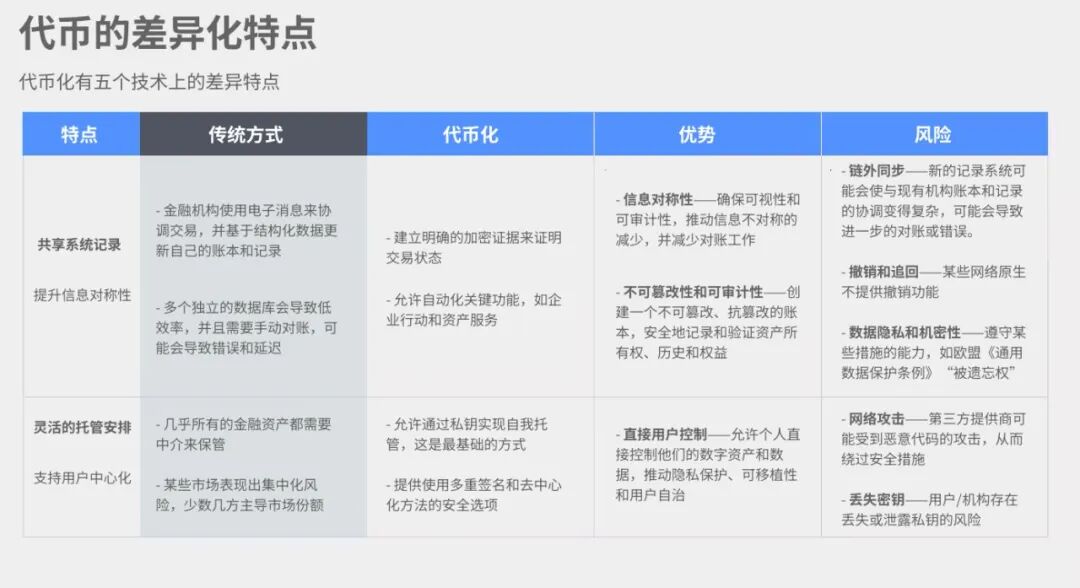

Asset tokenization is expected to open the doors of financial markets to everyone.
Image source: Getty Images/iStockphoto
Sandra Waliczek
Head of Blockchain and Digital Assets at the World Economic Forum
The financial markets are quietly undergoing a transformation driven by asset tokenization.
Asset tokenization can make investing easier, faster, cheaper, and more transparent.
When institutions, regulators, and technology providers work together to establish a trustworthy and interoperable framework, we can expect asset tokenization to fully unlock its potential.
Following the introduction of the U.S. GENIUS Act, the latest developments in U.S. currency regulation have put digital assets squarely in the headlines. While the regulation initially focuses on cryptocurrencies, the next phase of digital assets will shift toward asset tokenization.
In an increasingly digital world, financial markets are undergoing a quiet yet transformative shift—one that promises to make investing more accessible, affordable, and transparent. Driving this revolution is asset tokenization, a concept that leverages blockchain technology to digitize and decentralize ownership of real-world assets like stocks, bonds, and real estate.
While the concept of digital assets may evoke images of volatile cryptocurrencies, asset tokenization is entirely different—and its potential to transform global finance could be even more profound.
It's important to emphasize that asset tokenization is not the same as digital payments. At its core, tokenization has the potential to democratize access to financial markets by unlocking ownership of assets that were previously inaccessible—particularly benefiting retail investors and individuals in emerging economies who often struggle to reach traditional financial institutions.
The World Economic Forum recently released the report "Asset Tokenization in Financial Markets: The Future of Value Exchange," offering an in-depth exploration of this topic.
What is asset tokenization?
Asset tokenization is the process of creating a digital representation, or "token," of a real-world asset on a distributed ledger or blockchain. These tokens are programmable, traceable, and can be transferred peer-to-peer.
Each token serves as a digital certificate representing ownership of an asset—or a fractional share of an asset. For instance, instead of purchasing an entire stake in a private company or an entire commercial building, investors can now acquire a portion of the asset, symbolized by the token. These tokens can be traded on blockchain-based systems, enabling round-the-clock, global transactions.
Segmented Advantages
Asset tokenization offers several potential advantages over traditional finance, particularly in terms of accessibility, efficiency, and transparency.
1. Democratization of Financial Market Access
One of the most powerful potentials of tokenization lies in its ability to create a level playing field for retail investors and investors in emerging markets. In the past, high capital requirements, regulatory barriers, and limited global market access have restricted investments in certain asset classes—such as private equity, real estate, or commodities—to institutional investors or ultra-high-net-worth individuals.
Tokenization is transforming this reality by enabling asset fractionalization—breaking down large, high-value assets into smaller, more affordable units. For instance, residents of Bangkok could purchase a single token representing a share in a landmark office building in the city. This significantly lowers the entry barrier, allowing more people to participate in wealth accumulation.
In emerging economies where capital markets are still underdeveloped, tokenization can also serve as a powerful tool. With just a smartphone and internet access, individuals can invest in financial assets, bypassing some of today’s existing restrictions—while still ensuring investor protection.
2. Cheaper and more efficient transactions
The traditional financial system is quite complex, costly, and suffers from slow settlement processes. In contrast, tokenization replaces many of these layers by leveraging "smart contracts"—self-executing code embedded within blockchain networks. In emerging markets, adopting this technology could mean leapfrogging the limitations of conventional systems altogether.
These smart contracts can automatically execute tasks such as compliance checks, dividend payments, or settlements, reducing human error and lowering operational costs. Such efficiency will directly translate into cost savings, particularly benefiting small investors who are more sensitive to fees.
Asset custody has also become more flexible. Investors can either manage their wallets independently, tailoring them to their personal preferences and risk tolerance, or opt for custodial services, allowing for a more personalized financial experience.
3. Faster settlement speed
In traditional markets, transaction settlement can take several days due to the involvement of multiple parties and the reconciliation process. However, by using tokenized assets, settlements can be executed almost in real time on blockchain networks.
This speed is especially critical for cross-border transactions—previously, cross-border settlements were often delayed by factors such as time zone differences, regulatory scrutiny, and interbank clearing processes—but now, efficiency can be significantly boosted.
4. Greater transparency and trust
One of blockchain's most core advantages is its "shared ledger system"—a single, tamper-proof record that participants can access. Imagine a long list containing every transaction ever made: whenever a new transaction is recorded, every computer on the network verifies it. This transparency enhances visibility into ownership structures, transaction histories, and the origins of assets.
For financial regulators, this means audits and compliance oversight become more efficient. For investors, it translates into greater trust-building. When every transaction is recorded in real time and fully traceable, activities like fraud, double spending, or market manipulation become far harder to pull off.
This transparency reduces information asymmetry, enabling participants to better understand the asset situation and potential risks.

Image source: World Economic Forum report "Asset Tokenization in Financial Markets: The Future of Value Exchange"
Challenges and risks remain.
Of course, promoting asset tokenization also faces numerous challenges, and the current adoption rate remains uneven, constrained by:
Interoperability between blockchain networks and traditional infrastructure remains limited.
The legal framework for tokenized assets is unclear.
Liquidity issues in the secondary market.
Design choices also require careful consideration—such as whether to use a permissioned or permissionless ledger. And what about the selection of settlement assets: should they be stablecoins, central bank digital currencies, or traditional fiat currencies? Finally, how can we ensure robust cybersecurity and privacy? The answers to these questions all demand thoughtful deliberation.
Nevertheless, major financial institutions and policymakers are increasingly recognizing the existence of these barriers and are working diligently to promote standardized, coordinated frameworks that will ensure the healthy expansion of the tokenized market.
Real-world use cases are emerging.
Asset tokenization is being piloted across multiple financial sectors:
1. Issuance:Digital-native bonds and stocks are being issued on blockchain platforms, reducing underwriting costs and shortening time-to-market.
2. Securities Financing:By tokenizing collateral, real-time margin management and risk control are achieved.
3. Asset Management:The fund is exploring the tokenization of its shares, giving investors greater flexibility and control over their holdings.
As these pilot projects mature and infrastructure improves, "seamless composability" will soon become a reality—allowing tokenized assets to flow freely across multiple applications and platforms.
The Path Ahead
Asset tokenization is still in its early stages, but its direction of development is becoming increasingly clear. As technology, regulation, and market structures evolve, tokenized finance will emerge as a key pillar of the next-generation financial system. It will lower barriers, reduce transaction friction, and enhance both the accessibility and transparency of assets.
As institutions, regulators, and technology providers jointly build a trustworthy, interoperable framework, asset tokenization is poised to unlock its full potential.

The above content solely represents the author's personal views.This article is translated from the World Economic Forum's Agenda blog; the Chinese version is for reference purposes only.Feel free to share this in your WeChat Moments; please leave a comment at the end of the article or on our official account if you’d like to republish.
Editor: Wang Can
The World Economic Forum is an independent and neutral platform dedicated to bringing together diverse perspectives to discuss critical global, regional, and industry-specific issues.
Follow us on Weibo, WeChat Video Accounts, Douyin, and Xiaohongshu!
"World Economic Forum"


